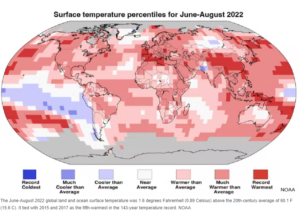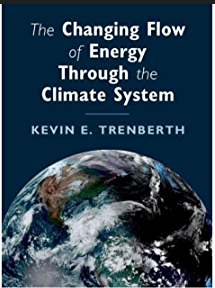Could years of drought in India strike again, bringing famine and mass migration? New science says “yes”. Professors Gayatri Kathayat and Ashish Sinha explain. NCAR scientist Kevin Trenberth reports two marine heat waves right now. Endangered tree expert Malin Rivers with a survey of global trees. Scientists warn almost a third of tree species are in danger of extinction.
Listen to or download this Radio Ecoshock show in CD Quality (57 MB) or Lo-Fi (14 MB)
A quick note: in last week’s show, Stanford’s Professor Rob Jackson said recapturing the powerful warming gas methane may be humanity’s only way to save a livable climate in our lifetime. Then someone blew up two massive natural gas pipelines under the Baltic Sea. Methane is erupting out of the sea into the atmosphere by the ton. Experts like Drew Shindell say that methane is not enough by itself to warm the planet much. Rob Jackson says whoever blew up those pipelines should be charged with War Crimes. I guess we don’t have Climate Crimes yet.
=======================================
Did you know Radio Ecoshock is entirely dependent on donations from blog-readers like you? The 106 radio stations do not pay for this program. Stations do not allow fundraising by program producers. As you can see, there are no ads or sign-up memberships popping up here. I don’t sell t-shirts or coffee mugs.
Your donation pays for things like access to books or papers, program production software, specialized recording computers and associated hardware, download costs for “every file free” on this web site, etc. etc. Can you help keep this going? I’m looking for one-time donations or monthly donations – any amount you can afford.
=======================================
THE INDIAN MONSOON CAN FAIL FOR YEARS:
GAYATRI KATHAYAT AND ASHISH SINHA
Even without climate change, some natural systems are unstable. Long droughts, running from decades to centuries, were not uncommon in the last few thousand years. They appeared in the American SouthWest, Australia, and many other places. In the early 1790s, the Indian Summer Monsoon failed several years in a row. An estimated 10 million people died of famine. Now the Indian Monsoon rains have to feed over a billion people.
Listen to or download this 22 minute interview with Gayatri Kathayat & Ashish Sinha in CD Quality or Lo-Fi
There is something for everybody in this paper – a marriage of history and science, stories of mass famine killing millions, and questions about climate stability and our assumptions about the future. The title is: “Protracted Indian monsoon droughts of the past millennium and their societal impacts”. It was published in the Proceedings of the National Academy on September 21st, 2022. However, the paper is behind a paywall and it’s a difficult read with lots of tech notes. You may prefer this interview, and other articles listed below.
The lead author Gayatri Kathayat is Associate Professor at Xi’an Jiaotong University, in China. Second author is Professor Ashish Sinha from California State University, teaching Big Ideas in Earth Science.


Dr. Ashish Sinha & Dr. Gayatri Kathayat
“Dr. Sinha is a Professor in the Earth Sciences Department. He teaches courses in Global Change, World Ocean, Earth’s History, and Big Ideas in Earth Science. Professor Sinha’s research centers on climate change with a particular focus on high-fidelity reconstruction of precipitation patterns in tropical and monsoonal locations over the past several millennia.” Sinha has co-authored a number of papers on the Indian Monsoon over the past 4,000 years, and related collapse of civilizations. One 2012 paper led by M. Berkelhammer says:
“The emergence of high-resolution proxy records from the Asian monsoon region suggests that the monsoon system is bistable and can abruptly transition between a suppressed and active state.“
Climate models and governments assume the Indian summer monsoon is self-regulating, keeping within a narrow range between dry and wet years. This work from Kathayat and Sinha suggests instead: “a system prone to abrupt nonlinear transitions between strong and weak states”.
Our guests tell us about 60% of agriculture in India – which feeds over a billion people! – is dependent on rainfall from the summer monsoons. That has failed, leading to widespread drought in the last 100 years, but only for a year, not many years. But the historic record shows the monsoons can fail to feed India many years in a row. Recurring drought appears over a decade.
WHAT HISTORY SAYS ABOUT DROUGHT AND FAMINE
The records come from two sources. First, India has a long (thousands of years) or literary traditions. Many of the ancient documents speak of long droughts (and famine). Eventually British records add to that history. The Kathayat/Sinha paper says:
“For example, classical ancient Indian texts such as Arthshastra (ca. 150 CE) and Rigveda (ca. 1500 BCE) contain numerous accounts of continuous multiyear droughts and ensuing famines, some lasting for as long as 12 y (7). Periods of protracted droughts (defined here as droughts lasting more than three consecutive years and/or multidecadal periods with drought every other or every third year) are evident in the systematic compilations of historical droughts and famines that occurred between ~1500 CE and 1900 CE.”
But how reliable are those stories – especially when current climate models do not show long droughts when creating the past?
WHAT THE CAVES RECORD
There is a another record, kept by nature not by humans. In a certain cave in Northeast India, conditions are perfect to record rainy years and drought. When it is wet – and it can get very, very wet, – water drips down from the ceiling of the cave to form piles of stone, like limestone, on the bottom of the cave. These are called “stalagmites” – one of several varieties of cave drippings called “speliothems”.

“Mawmluh cave is located in one of the wettest places on Earth with an average annual precipitation of over ~11,000 mm [443 inches or almost 37 feet of rain a year, average!], with 70 to 80% of its annual precipitation falling during JJAS (June to September).”
Mawmluh Cave is listed as UNESCO’s one of the ‘First 100 IUGS (International Union of Geological Sciences) Geological Sites’ in the world. It is becoming a tourist destination. Scientists, led by Gayatri Kathayat, who has been in Northeast India for the last 10 years, managed to measure rains for the last 1,000 years. Because the rock conditions are perfect, the experts are able to identify the year within a four year margin of error. This allows them to find even short-term droughts, and certainly the big ones. Generally, the physical record reinforces the historical accounts.
TERRIBLE DROUGHTS FROM 1780s TO 1810s – MILLIONS DEAD
From this paper (Kathayat/Sinha)
“The period from the 1780s to 1810s stands out as an exceptional interval in both historical and proxy data. The historic drought compilations for this period principally draw their information almost exclusively from one East India Company report by F. C. Danvers, a British officer with the company. His report, in turn, was compiled from contemporary accounts of droughts and famines from various regions of the subcontinent.
Danvers’ report—“A Century of Famines”, shows that there were at least 11 drought-related famines during this period, six of which, including the well-known Chalisa and Doji Bara or Skull Famines, occurred between ~1782 and 1792 CE, with a combined estimated death toll in the excess of 11 million, making it one of the deadliest decades in Indian history.”
After another famine, the one-time capital of the Mughal Empire was completely abandoned by 1610 (Fatehpur Sikr). That is serious. The failing monsoons also affected Tibet and China, like the “so-called ‘Ming Dynasty drought’ (~ 1638 to 1641 CE) that affected large parts of northern China and India.” So this isn’t just a story about India.
Environmental historian Richard Grove published in Nature the fatal Indian drought may have been part of a world-wide reaction to El Nino. But Kathayat and Sinha write the mechanism of the Indian Monsoons are still not fully known. They could be driven by an internal mechanism that requires no outside forcing like an El Nino, or even climate change. Nobody knows how climate will rearrange the already unstable Indian Monsoon system. That is a huge unknown risk. This paper has a section on the Monsoons and the ENSO system. They caution: “not all summer monsoon droughts are caused by El Nino events over India.”
Kathayat and Sinha question whether this recurring pattern of drought in late 1700’s India contributed to a “deindustrialization” of India in that period. The arrival of the British Empire trading system was probably the main reason India no longer became the workshop of Asia, as it had been under the Mughal Empire (around 1650 to 1750). But drought would have increased food prices, which led to rising wages hurting India’s competitive position. We still have a lot to learn about the real impact of long-term drought where a billion people presume rains will feed them.
By the way, the long periods of drought were often followed by a decade or more of extremely heavy rains and flooding. This looks like an unstable two-pole system. It looks to me like global warming could push that to even further extremes (but this is unknown). The authors say present day Indian water planning and other social infrastructure, including agriculture, does not include preparing for extended drought years. They say:
“Recurrence of protracted droughts can easily overwhelm the adaptive capabilities of modern societies unless a longer-term and holistic understanding of monsoon variability is incorporated into drought management and mitigation planning.”
OTHER PARTS OF THE WORLD NEED TO PAY ATTENTION
This study reminds me of findings that white settlers coming to Australia lucked out by arriving during a long wetter period, helping agriculture. We do not know if Australia is now entering a very long dry period, or whether global warming will make that more likely.
Modern humans think this civilization is stronger than such natural events. If there is a crop failure in India, we will ship in grain from somewhere else. With over a billion Indians, I doubt that. What are your concerns for India, and do you think planning for such extremes is possible? What would be the impact of a multi-year drought on the global economy? India is again a global workshop and tech hub. In a long agricultural failure, would a tide of Indian migration overwhelm parts of the world, with political repercussions?
===========================
KEVIN TRENBERTH: HEAT WAVES IN THE SEA
This is the third of three conversations with Dr. Kevin Trenberth in New Zealand. Stefan Rahmstorf, a leading scientist, calls Trenberth a “top climate scientist”. That follows a long career of insightful research papers and leading role in reports by the Intergovernmental Panel on Climate Change (IPCC). Now we are working with Kevin’s new climate textbook for all: “The Changing Flow of Energy Through the Climate System”.
Listen to or download this 16 minute interview with Kevin Trenberth in CD Quality or Lo-Fi
Kevin Trenberth spent 42 years as a scientist in the United States, leading climate analysis for NCAR, the National Center for Atmospheric Research. But when I read Kevin’s new book – he talks more about the role of the ocean than the atmosphere.
We are shocked at land temperatures in so many parts of the N. Hemisphere at once. Pakistan roasted, stormed, and about one third of the country went underwater with floods. In China, extreme heat stayed for weeks. More painful heat struck Europe and the U.S. Should we presume that ocean temperatures change so slowly, that all these land events are not accompanied by anything shocking in sea changes?
Kevin says “no”. The oceans are also heating due to the greenhouse effect. In fact, while Turkey and China continue their all-time heat records into October, there are two marine heat waves right now. One is in the Tasman Sea off New Zealand. The other is a giant blob of abnormally hot waters in the North Pacific. Here is Kevin’s heat map for 2022, found in his article just published in the Conversation: “2022’s supercharged summer of climate extremes: How global warming and La Niña fueled disasters on top of disasters”.

It bothers me when people say 90% of our excess heat goes into the ocean, as though that doesn’t matter. Marine heat waves endanger ocean life and warming waters melt polar glaciers. The excess heat we stuff into the sea will come back in future centuries. It’s like spending money on a credit card – putting off paying for warming – into future centuries.
STABILIZED EARTH?
Kevin Trenberth is a co-author of a paper released in July 2022. The title is: “The ocean response to climate change guides both adaptation and mitigation efforts”. Trenberth, John Abraham, Michael Mann and other eminent scientists suggest Earth temperature will stabilize when we stop adding greenhouse gases to the atmosphere. The planet will stop warming. I am doubtful about that. What about natural feed backs like thawing permafrost or melting clathrates? Should we really promise temperatures will stabilize as soon as we kick the fossil habit?
Kevin publishes heavily-cited papers fundamental to climate science. His new book is “The Changing Flow Of Energy Through The Climate System“. That book lived on my bedside table all summer as my teaching guide.

======================================================================
SCIENTISTS WARN: TREE SPECIES ARE DISAPPEARING
DR. MALIN RIVERS
Humans spend trillions to get off this planet and we still don’t know who lives on this one. For example: nobody is sure how many kinds of trees there are. What we do know now: after a massive multi-year project, scientists report back with a warning: Earth is losing tree cover. And trees are facing a massive species extinction event. That affects everything, from the economy to climate and countless other species.
Experts behind the Global Tree Assessment just issued their: “Scientists’ warning to humanity on tree extinctions.” This paper is Open Access, free for you to read. Here to explain why the plight of trees matter, is the lead author, Dr. Malin Rivers. She is an internationally recognized expert from Botanic Gardens Conservation International.

Dr. Malin Rivers
Listen to or download this 20 minute interview with Malin Rivers in CD Quality or Lo-Fi
In this Warning we find:
“Societal Impact Statement
Trees play vital roles in many of the world’s ecosystems while providing many benefits to people. New evidence indicates that a third of tree species are threatened with extinction, representing a tree extinction crisis. Here we demonstrate how tree species extinction will lead to the loss of many other plants and animals and significantly alter the world’s ecosystems.
We also show how tree extinction will negatively affect billions of people through loss of livelihoods and benefits. We highlight a series of urgent actions needed to avert an ecological, cultural and socio-economic catastrophe caused by widespread extinction of tree species.”
In 1992, over 1700 scientists called for an end to environmental destruction and new relationships with nature. A second warning came out, this time with over 15,000 scientist signing. Radio Ecoshock guest William Ripple led that Second Warning in 2017.
Since then, Second Warnings came out from specific fields, like (quote from the paper) “scientist warnings to humanity on microorganisms and climate change (Cavicchioli et al., 2019), insect extinctions (P. Cardoso et al., 2020), the freshwater biodiversity crisis (Albert et al., 2021)”… and more. Scientists in many fields are deeply worried about the future for nature, and of course, for our species.
Now, unseen to most of us, the forest experts warn us:
we are approaching extinction of tree species, with widespread impacts throughout not just nature, but our human economy.
I bet more of our listeners have never been in a first-growth mature forest. The canopy is so full, primordial forests in the North are dark places, a little foreboding, a place humans to travel through, but do not stay. Human beings apparently evolved from ape-like creatures adapted for living in trees. Now the city dweller is estranged from the trees. That is part of the problem.
THE FOREST NEWS IS NOT GOOD
These authors report:
“… global forest area has declined by around 40% in the past 300 years, and 25 countries have lost their forest cover entirely (Shvidenko et al., 2005). At the same time, many remaining forest areas have been highly degraded by unsustainable land use practices such as illegal extraction of timber.”
29% OF TREE SPECIES THREATENED WITH EXTINCTION!
This is just out. We are rapidly losing species, and all the creatures they support. Forever. Why have we not heard that in headline news stories? The web site for the Global Tree Assessment is here. Their web site says:
“Around 43% of the already assessed trees are assessed as threatened to some level and 37% of all assessed trees are threatened globally. This means that at least 29% of all tree species are threatened with extinction globally.”
Read more about the Scientists’ Warning on Earth’s trees from Science Alert here.
================================================
That’s it for this week. Please don’t forget to support the show. Tune in next week as we explore investigative reporting into the Big Lie from fossil fuel companies. It filled their pockets and helps wreck the future for all species.
Thank you for listening, and caring about our world.